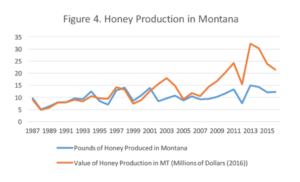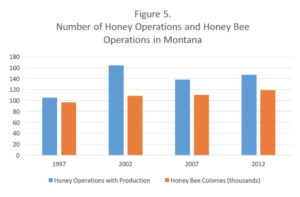A recent update from the Montana State University College of Agriculture indicated that, “Honey is probably not one of the primary agricultural products that most people associate with Montana, but in fact, Montana was the third largest honey producing state in 2016. Montana produced over 12 million pounds of honey in 2016, and it ranked fifth in the country for number of honey bee colonies.”
The update explained that, “The number of commercial honey bee operations in the United States has grown in recent years, partly in response to agricultural demands for pollinators during bloom.
“Many larger-scale producers transport honey bees from crop-to-crop throughout the winter and spring, returning the bees to northern states like Montana to produce honey in the summer. Montana summers, with their long days, cool nights, and wide variety of flowering plants, provide a good environment for honey production.
“Commercial pollination season begins in February in the flowering almond groves of California. Cross-pollination is vital to almond production. Every almond farm has at least two varieties of almond trees, but bees are needed to transfer pollen from one variety to the other. During almond blossom, the bee colonies work in a state of energy deficit, producing no excess honey. After the almond blossom, beekeepers begin moving their bees north again, leasing the bees to pollinate various crops along the way. The beekeepers retain rights to the honey as the bees pollinate, but honey production and flavor vary across crops. Fees paid for pollination are lower for crops that yield more marketable honey (Rucker, Thurman, and Bugett, 2012).”
The Montana State article added that, “After an intense season of pollinating almonds and other crops, beekeepers usually allow the bees to rest and produce honey. Figure 4 [below] plots honey production in Montana over time, both in pounds and value of honey production. The figure indicates that honey production has risen over the past 3 decades. Figure 5 [below] shows a simultaneous rise in the number of honey producers and bee colonies in Montana since 1997. (Note that some beekeepers keep their bees in Montana year-round, using the bees only for honey production). These figures suggest that honey production is an important and growing industry in Montana, and it is closely linked with crop production in other states.”

Graph from, “Montana: A Honey State” by Diane Charlton. Montana State University (May 1, 2017).

Graph from, “Montana: A Honey State” by Diane Charlton. Montana State University (May 1, 2017).

